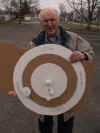|
Paper Plate Education
"Serving the Universe on a Paper
Plate"
Activity: Geocentric vs. Heliocentric





Geocentric World Demonstrator
By John Beach
The device shown here is useful in illustrating the geocentric
system refined by Ptolemy about 125 AD. It consists of a few foam balls
and several cardboard disks mounted on a sheet of cardboard. Three disks
of the type used by purveyors of pizza are mounted concentrically on a sheet of
cardboard, with the middle disk reversed for color contrast. A foam ball
mounted at the center represents the Earth. Two smaller disks serve as
epicycles for an inner planet such as Venus and an outer planet such as Mars.
The outer disk is labeled with the names of the constellations behind the Sun at
the times when the season changes. A foam ball mounted near the edge
of the inner disk represents the Sun.
I use this device after spending some time familiarizing students with the
observations of the apparent motions of the stars, Sun, and planets which people
have made over many centuries. In operation, I start with Gemini and the
Sun at the top and rotate the constellation wheel one full turn to show what the
geocentrists believed was happening during a day. I point out
that the sun makes a bit less than one full turn a day in order to allow for the
apparent motion of the Sun along the ecliptic. During the second day, the
stars rotate again one full turn, while the Sun drops behind approximately
another degree. After 90 days, the Sun is in front of Virgo and in 365
days it is again in front of Gemini.
For Mars, the operation is a bit more complicated. When the stars
make their daily rotation, Mars also drops behind, but not by as much as the
Sun. Starting with Mars in opposition, it takes Mars 779 days to return to
opposition to the Sun, and it takes 779 days for Mars to move once around its
little epicycle. Ptolemy introduced epicycles in order to produce the
retrograde motion.
Venus is never at opposition, but starting from maximum elongation, it needs 583
days to return to the same position relative to the Sun. As the Sun makes
its daily revolution about the Earth, Venus makes 1/583 of a revolution around
on its epicycle, which is centered between the Earth and the Sun. (Venus'
epicycle had to be centered between Earth and Sun because it never gets more
than about 46 degrees from the Sun.)
Another model (not shown here) does not have the planets with their epicycles,
but has instead the Sun and Moon mounted on the middle and inner disks,
respectively. It is useful in showing how the Sun falls behind the stars
in revolving around the Earth, and how the Moon falls even farther behind.
By changing the labels, this model is also useful in showing the cause of
retrograde motion in the system of Copernicus.
These models are easily and inexpensively made and are effective in getting the
concepts across. Their use should serve as an answer to the problems which
arise from the observations of the sky, real or perceived through use of charts,
planetaria, or hopefully, the real sky. Even though the geocentric system
is wrong, students need to realize that for the ancients, it was right. It
was right because it explained what they saw, it led to accurate predictions,
and it justified their firm belief that the Earth must be stationary at the
center.
Contributed by John Beach.
|